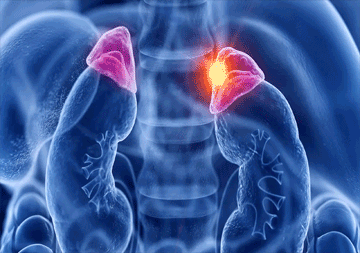What is Neuroblastoma?
Neuroblastoma is the most common abdominal tumor in children specially below 5 years of age. It develops inform the neural crest cells of the parasympathetic nervous system which is still developing. Neuroblastomas can arise from a small gland called adrenal gland which is situated just at the tip our kidneys. Around 30% of them arise from adrenal gland whereas 60% arise from admonial paraspinal area (around the spinal cord) and remaining can arise in the chest and neck tissues.It is a fast growing tumor and t is capable of spreading to other parts of the body.Adrenal glands produce hormones that regulate automatic body functions like digestion, blood pressure, breathing, and heart rate. Symptoms and signs can vary depending on the location of the tumor.
The prognosis for children with neuroblastoma is determined by the tumor's location, the child's age, stage of the disease and genetic mutation status. The stage of the disease describes how far it has spread inside the body.

What is the prevalence of Neuroblastoma?
Neuroblastoma is a rare cancer, but it is the most common cancer in infants. It accounts for 8-10% of all childhood cancers. Every year, approximately 800 children in the United States are diagnosed with neuroblastoma. Neuroblastoma almost always appears before the age of five. It can happen to babies even before they are born. Neuroblastoma is extremely rare in children over the age of ten.
What causes Neuroblastoma?
Neuroblastoma develops when immature nerve tissues (neuroblasts) grow uncontrollably. The cells become abnormal and continue to grow and divide, eventually forming a tumour. A genetic mutation (a change in the genes of the neuroblast) causes the cells to grow and divide in an uncontrollable manner. The cause of the genetic mutation is unknown to Doctor.
Children with a family history of neuroblastoma are at a higher risk of developing the disease. However, neuroblastoma is not inherited 98% to 99% of the time (or, passed down in families). Children born with other congenital anomalies (birth defects) may be predisposed to neuroblastoma.
What are the signs and symptoms?
- Signs and symptoms depend on the location of the primary tumor or metastatic spread. The disease can spread to liver, bone, bone marrow, lymph nodes, skin.
- Child can present with abdominal distension, usually noticed by the mother if it arising from abdomen.Child can also present with diarrhoea, high blood pressure, sweating and high heart rate, dark colour of skin around the eyes, bone pain, scalp swelling
- Paraspinal tumors can present as weakness in legs (paraplegia) or inability to pass urine (urinary retention.
Diagnosis:
- A biopsy is necessary to confirm the diagnosis and it also gives other information for risk stratification.
- MIBG scan or PET CT scan is done to look for spread of the disease
- Bone marrow biopsy is also done to look for any involvement of bone marrow by the neuroblastoma cells
- MYC N amplification test is necessary for risk stratification. This oncogene is present in about 25% of neuroblastoma patients. If this gene is amplified (positive) then those patients are very high risk and they need more intensive treatment.
- Blood test include complete blood counts, liver function and kidney function tests, LDH, ferritin levels
- Urinary VMA – vanilyl mandelic acid (VMA) is secreted in majority of neuroblastoma patients. If its high before starting treatment, then it is a good follow up test to look for treatment response.
What are the different stages of Neuroblastoma?
There are different staging systems developed over the period of time. INRGSS (International Neuroblastoma Risk Group Staging System) is now being used.All patients of neuroblastoma will need risk stratification, that means based on age, stage, biopsy report, molecular oncogene report, patient is categorized as low risk, intermediate risk or high risk. Treatment is different for different risk group.
Treatment:
- Treatment is based on risk stratification. Most of the patients need chemotherapy and surgery. Some high risk patients need radiation therapy also.
- Low risk patients are treated with surgery.
- Intermediate risk patients will need chemotherapy followed by surgery
- High risk patients are treated with intensive chemotherapy followed by surgery and radiation therapy in some cases and then autologous stem cell transplant followed by maintenance therapy.
- A new drug called Denutuximab has shown very good results in high risk neuroblastomas when given during maintenance treatment.
For enquiries, bookings or support, call us at +91-96508 06846
Need help? Get a call back from our support team
Contact Us

